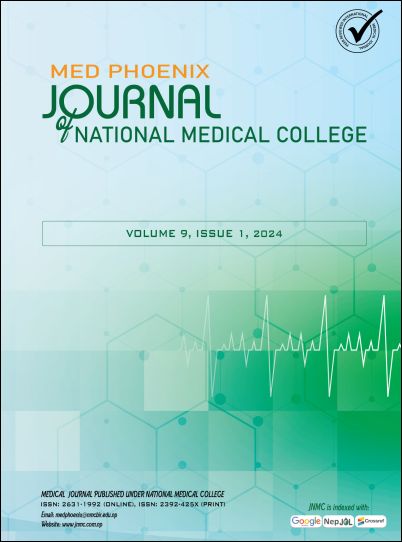Vaginal Bleeding in Early Pregnancy: Patterns, Predictors and Association with Misacarriage
DOI:
https://doi.org/10.3126/medphoenix.v9i1.67180Keywords:
Abortion, First trimester, Implantation, Pregnancy, Vaginal BleedingAbstract
Introduction: First trimester vaginal bleeding is common in pregnancy; however, few data have described the distribution characteristics and predictors of early bleeding episodes. Bleeding characteristics such as heaviness, duration, timing and color predictive of miscarriage were identified. Maternal conditions (Diabetes, Thyroid disease, Fibroids), prior pregnancy outcomes (miscarriage, induced abortion), reproductive tract infections, smoking and alcohol intake are also predictive of bleeding. Women who report heavy bleeding has nearly three times the risk of miscarriage compared to women without bleeding. This study is carried out to evaluate the association between patterns of bleeding in early pregnancy and the occurrence of miscarriage as well as to identify the maternal characteristics that predict bleeding in early pregnancy including maternal age, maternal co morbidities, prior history of abortion and cycle characteristics.
Materials and Methods: A hospital based cross-sectional study conducted at tertiary care hospital for a period of one year from December 2022 to December 2023. A total of 164 singleton gestation with vaginal bleeding up to 24 weeks with meeting the inclusion criteria were enrolled in the study after taking consent.
Results: Among all the participants (n= 164) only 6.70 % of women with bleeding reported heavy bleeding, of the spotting and light bleeding episodes (n= 153), 23.52% were associated with pain. Among heavy episodes (n= 11), 100 % were associated with pain. Most episode lasted less than 3 days and most occurred between gestational weeks 5 to 8. 4.87% of women with bleeding experienced Complete abortion, 20.73% of women experienced Incomplete abortion,14.02% experienced Missed abortion, 9.75% experienced Threatened abortion, 4.87% experienced Inevitable abortion, 15.24% had Ectopic pregnancy, 11.58% had Subchorionic hemorrhage, 12.80% had Blighted ovum and 6.09% had Vesicular Mole. Maternal characteristics associated with bleeding include fibroids, prior miscarriage, thyroid disease, abnormal BMI, Smoking, Mullerian anomalies, Uncontrolled Diabetes Mellitus, Pelvic infections and Menstrual cycle irregularities.
Conclusion: Consistent with the hypothesis that bleeding is a marker for placental dysfunction, bleeding is most likely to be observed around the time of the luteal-placental shift.
Downloads
Downloads
Published
How to Cite
Issue
Section
License
Copyright (c) 2024 Med Phoenix

This work is licensed under a Creative Commons Attribution-NonCommercial 4.0 International License.
This license enables reusers to distribute, remix, adapt, and build upon the material in any medium or format, so long as attribution is given to the creator.
Copyright on any research article is transferred in full to MED PHOENIX upon publication. The copyright transfer includes the right to reproduce and distribute the article in any form of reproduction (printing, electronic media or any other form).




